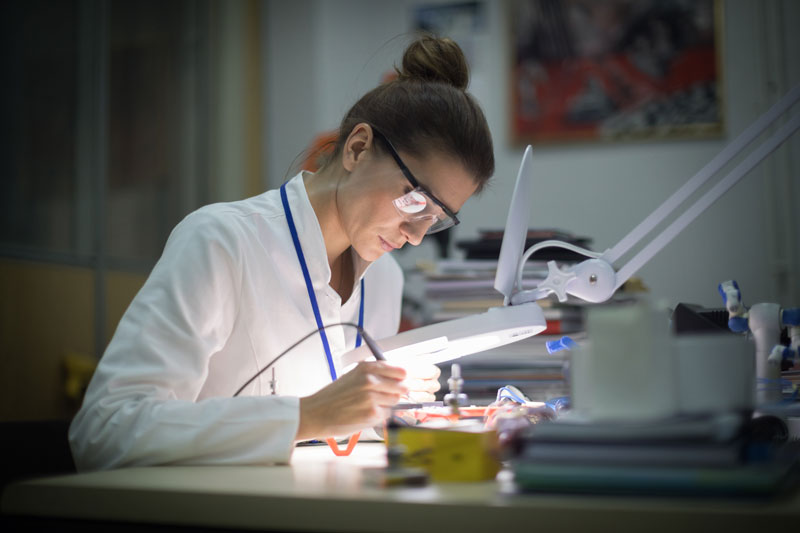Despite the coronavirus pandemic, the high skilled manufacturing operator remains an integral part of the manufacturing landscape.

A lot has been written and said in recent weeks about how things will never go back to the way they were, before Covid-19. And in many ways that might be true. Who wants to fly from Europe to the US for a 2 hour meeting anyway?
Digital transformation is, without a doubt, helping to automate many archaic business processes, and manufacturing is no exception. But what about the role of the frontline manufacturing operator? Are robots and machines about to spell the end for this honourable craft?
If Elon Musk’s recent quote is anything to go by then the answer is a resounding “no”. The technology entrepreneur, who is bringing us everything from electric cars to space travel, recently commented on his own manufacturing philosophy: “Yes, excessive automation at Tesla was a mistake. To be precise, my mistake. Humans are underrated”.
The manufacturing operator has many names; operator, product builder, production operator, assembly line worker, I could go on. But one thing is for sure; they are a vital cog in the production of many of the goods we need to live our lives. They are the true value-add workers in a manufacturing organisation. After all, if it wasn’t for them, there would be no product, no customers, no revenue. But does that make them indispensable?

Before we get into that, it’s important to acknowledge that there is certainly a case for automating many manufacturing processes. Processes that are repetitive, monotonous, low in complexity and easy to replicate should at least be considered for automation. It’s a no brainer to produce goods like computer chips and plastic bottle caps with machines and robots. They are high volume, easily repeatable processes that will give you a return on your investment in no time.
But what about complex medical devices, delicate electronic goods, ever-changing clothing lines or even high value jewellery? Will they too fall to the mercy of automation?
With enough time, money, determination and effort, any manufacturing process can, in theory, be automated. But, in many cases it’s just not feasible to do so. There are, in fact, many advantages that people hold over their metal friends in these types of manufacturing environment. Here are a few…
Dexterity
The hand is one of the most complex and beautiful pieces of natural engineering in the human body. It gives us a powerful grip but also allows us to manipulate small objects with great precision. This versatility sets us apart from every other creature (and machine) on the planet. However, assembling something like a complex medical or electronic device takes more than a skilful hand. It takes careful hand-to-eye coordination to manipulate delicate components into position, and this is not easy when those same flimsy components can sometimes have a mind of their own. Try teaching a robot that the component may be flat or round, tacky or smooth and may bend left or right and you will face an uphill battle to produce a viable automation solution, particularly for low to medium volume products.
Intuition
During quality inspections, manufacturing operators rely on hi-tech equipment and training, but they also rely on their instinct and reasoning. This helps them to make the best possible decision about the quality of the products that they produce. No two products are exactly the same and many contain some sort of abnormality. Sometimes the abnormality is okay but other times it needs to be evaluated further, to determine if there is a risk to the end user. Robots can detect what they’ve been programmed to do very well, but what about those unexpected deformities that pop up on the manufacturing floor every day? That’s where human intuition is vital, particularly in the manufacture of high quality, high value products.
Flexibility
The flexibility of people is crucial to many manufacturing environments. And I’m not talking about the ability to touch their toes! Agile manufacturing is where an organization creates the processes, tools, and training to enable it to respond quickly to customer needs and market changes, while still controlling costs and quality. High skilled operators can switch from one type of manufacturing setup or flow to another with minimal effort. This is particularly important in low-to-medium volume or mixed model assembly lines and cells, where people must adapt to the changing needs of the business rapidly. Contrast that with our metal friends that work best when they are set up to run high volume, repeatable, consistent processes over and over again.
Feedback
People have 5 senses and for high skilled manufacturing operators, 4 or 5 of them come into play on the production floor every day. What they see, hear, smell, touch and even taste can give insights about the entire manufacturing environment, not just the process in front of them. Machines will tell you how they are doing, but not very much else. So, with the right tools and know-how, production operators can provide a deeper level of feedback, that leads to greater insights about how manufacturing is performing, where the problems lie and how to resolve them.

In truth, there’s a place for people and automation on the manufacturing floor of the future. But understanding where operators have a distinct advantage over automated machines is an important consideration in optimising any manufacturing environment. It’s often far more beneficial to focus on streamlining the manufacturing processes and flow to maximise the effectiveness of the operators, rather than automating for the sake of it. Couple that with simple digital tools, that allow the operators to quickly and easily quantify downtime and productivity, and you have a recipe for a much more streamlined and efficient manufacturing environment.
People may be susceptible to a virus right now, but our metal friends have been prone to one or two viruses over the years too! So, to all those highly skilled workers out there, sleep safely. Your dexterity, intuition, flexibility and feedback skills look set to keep you center stage in many industries for the foreseeable future, so you won’t be exiting stage left any time soon.
Request a free demo: Capturing manufacturing data through the production operators will greatly enhance your understanding of the manufacturing floor. Kt-Pulse is the first app-based product that captures data directly from the production operators in real-time, thus quantifying and visualising productivity and problem areas on easy-to-read dashboards. If you’d like to see for yourself how Kyzentree’s software, Kt-Pulse, can help you to measure productivity and quantify waste on your manufacturing floor more effectively, book a one-to-one, no obligation consultation today and we’ll showcase the benefits to you.
About Kyzentree: We are a recognised leader in improving productivity by making it easy to visualise and manage manufacturing operations. We specialise in operator-driven processes. We have brought together a team of manufacturing, lean-sigma and technology experts to bring you our flagship product Kt-Pulse™. Kt-Pulse is an app-based software solution built exclusively for monitoring any type of manual assembly, inspection or packaging process.

Anthony Cahill has over twenty years’ experience in various roles within the manufacturing sector. He has primarily worked in manufacturing operations that rely on people working with their hands, fixtures and semi-automated equipment to produce discrete goods across a range of industry types. With a background in lean manufacturing and six sigma principles, he has a passion for looking at challenging manufacturing environments and working with cross-functional teams to transform them into safer and more efficient work spaces for all concerned.
